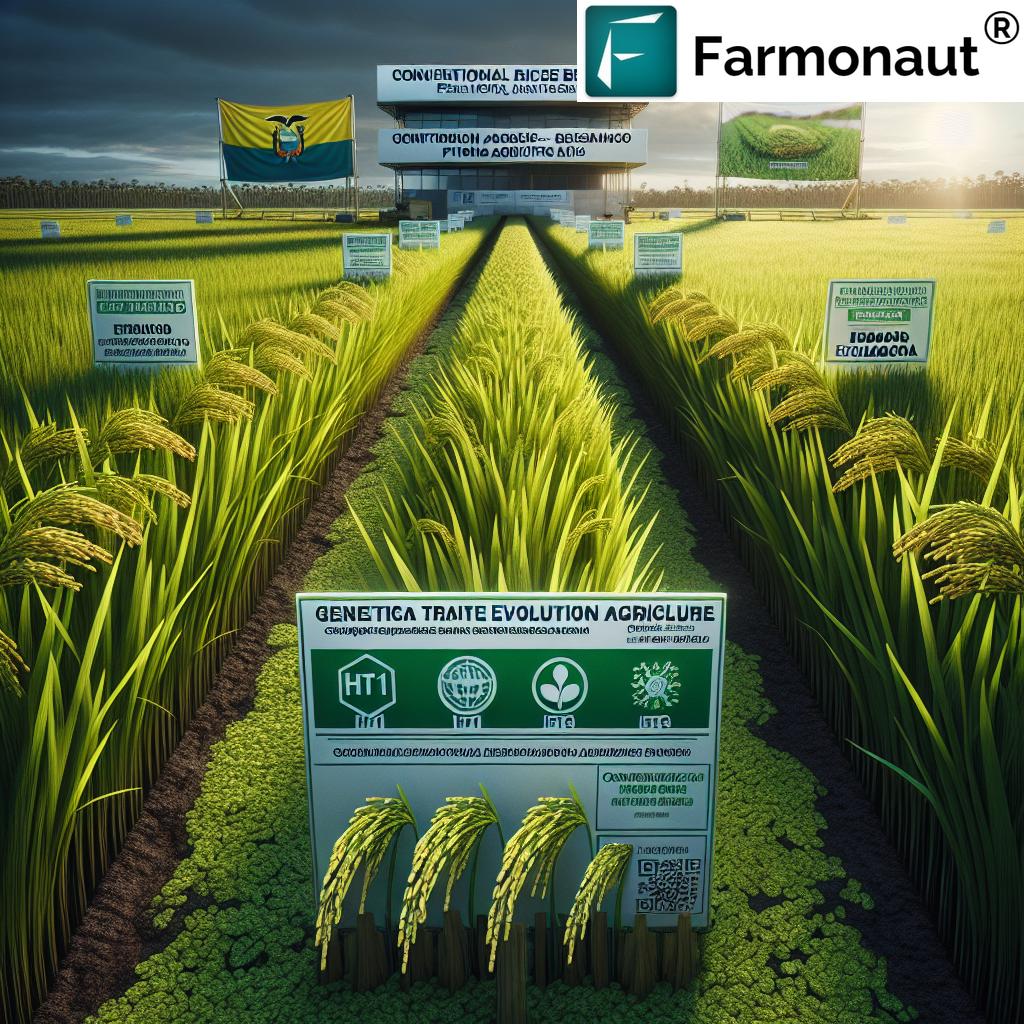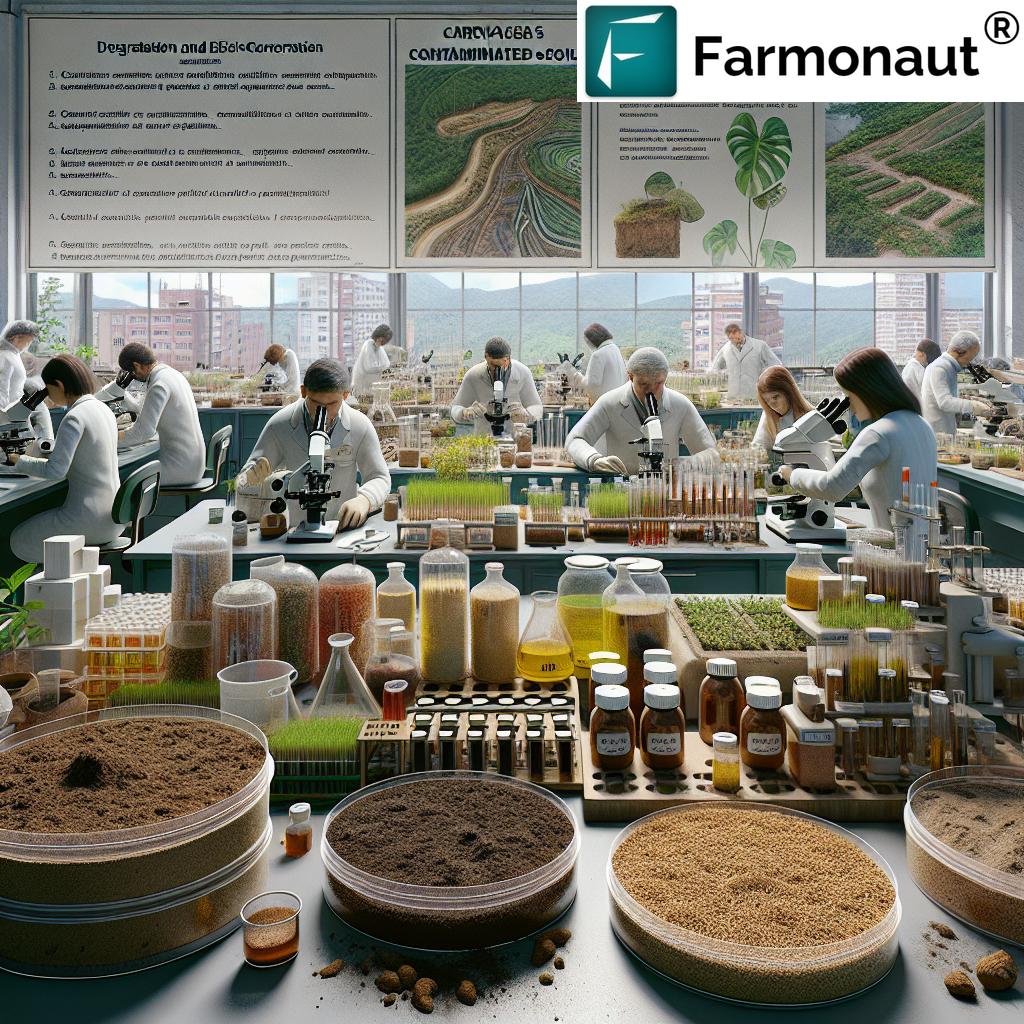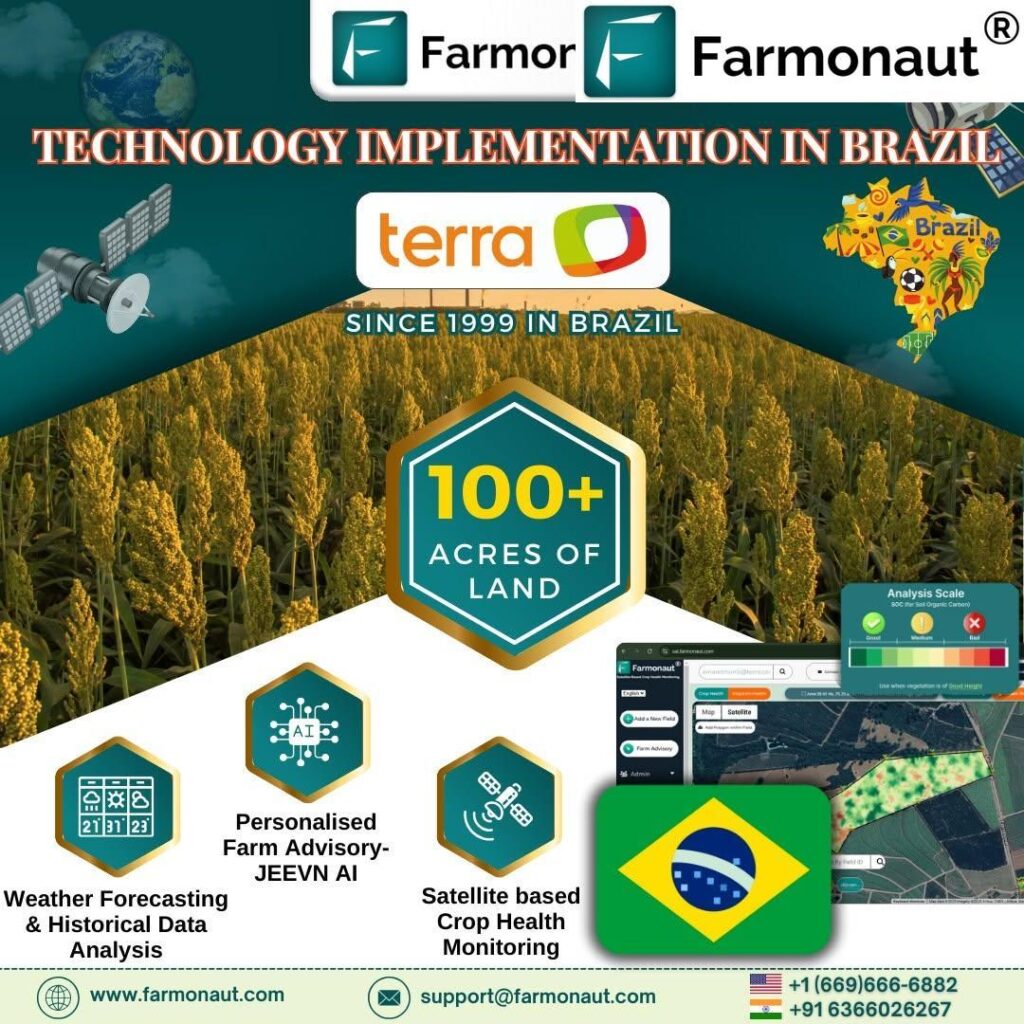Top 5 Herbicide Tolerant Rice Trait Advances in Ecuador Regulations
Meta Description: Top 5 Herbicide Tolerant Rice Trait Advances in Ecuador Regulations: Discover the innovation, genetic trait breakthroughs, and regulatory framework shaping Ecuador’s rice agriculture.
“**In 2023, Ecuador approved 2 new herbicide-tolerant rice traits, HT1 and HT3, under strict regulatory guidelines.**”
- Introduction
- Plant Trait Regulations in Ecuador: Context & Framework
- Why Herbicide Tolerant Rice Traits Matter in Modern Agriculture
- Top 5 Herbicide Tolerant Rice Trait Advances in Ecuador
- Comparative Feature Table: Leading Herbicide Tolerant Rice Traits
- Cibus, RTDS® Technology, and Targeted Genetic Changes in Rice
- Ecuador’s Regulatory Milestones for Rice Seed Development
- Impacts on Rice Agriculture, Economics & the Future
- How Precision Agriculture Technology from Farmonaut Empowers Rice Farmers
- FAQ: Herbicide-Tolerant Rice & Plant Trait Regulations Ecuador
- Conclusion
Introduction
In the evolving landscape of agriculture, advancements in rice trait development have become a fundamental pillar for food security, productivity, and sustainability. Nowhere is this more evident than in Ecuador—a country increasingly recognized for its forward-thinking approach to agricultural biotechnology. The move towards herbicide tolerant rice traits, specifically HT1 and HT3, marks a technological leap, underpinned by robust plant trait regulations and rigorous regulatory oversight by the Ecuadorian Ministry of Agriculture and Livestock.
Today, we explore the top 5 advances in herbicide tolerant rice traits in Ecuador regulations, with an exclusive focus on innovations such as those developed by Cibus, the implications of the country’s herbicide tolerance trait HT1 HT3 approvals, and what this all means for the future of rice farming, seed development, and genetic trait development in agriculture.
Plant Trait Regulations in Ecuador: Context & Framework
Understanding plant trait regulations Ecuador is key to appreciating the remarkable progress in the nation’s rice agriculture. The Ministry of Agriculture and Livestock acts in accordance with the Organic Law of Agrobiodiversity, Seeds and Promotion of Sustainable Agriculture and its Regulations—which uniquely positions Ecuador in regulating genetic development for crops such as rice.
- All rice cultivars with advanced traits must be registered before commercialization.
- Genetic trait products developed without integrated foreign DNA (i.e., non-GMO) are considered equivalent to those created via conventional rice breeding.
- This ensures scientific progress does not contravene Ecuador’s strict agricultural and environmental laws.
Regulations emphasize:
- Transparency and traceability in seed development
- Public safety, ecological integrity, and cross-border trade compliance
- Compliance for registration and commercialization under established frameworks, rather than restrictive transgenic (GMO) laws
Why Herbicide Tolerant Rice Traits Matter in Modern Agriculture
The introduction of herbicide tolerant rice traits is a transformative step for global and Ecuadorian agriculture. At the heart of these innovations is the goal to improve seed development, yield, weed resistance, and sustainability—fundamental drivers for advancing food security. HT1 and HT3, the recently approved traits within Ecuador’s regulatory landscape, are notable examples of how targeted genetic trait development in agriculture is reshaping farming practices.
With traditional methods, weed management in rice required extensive manual labor or the use of less selective herbicides, often resulting in crop damage. Herbicide tolerance trait HT1 HT3 empowers rice cultivation with:
- Increased flexibility for targeted herbicide applications
- Minimized crop loss from non-selective chemicals
- Improved environmental sustainability due to decreased chemical input
- Higher, more consistent yields for farmers
Top 5 Herbicide Tolerant Rice Trait Advances in Ecuador
Ecuador is a notable case study for agricultural trait regulations that successfully balance innovation with public and environmental welfare. The following are the most significant herbicide-tolerant rice trait advances shaping the future of rice production under the stewardship of the ministry and within the national regulations.
-
HT1 Trait (Cibus)
The HT1 trait, developed by Cibus using the Rapid Trait Development System™ (RTDS®), enables highly specific, targeted genetic changes in rice plants without recombinant DNA. This trait confers resistance to certain herbicides, allowing farmers to manage weeds more effectively without harming the rice crop itself. Its approval marks a milestone for non-GMO rice varieties in Ecuador’s herbicide-tolerant rice trait portfolio. -
HT3 Trait (Cibus)
Building on HT1, the HT3 trait offers an expanded resistance profile, accommodating a broader spectrum of herbicides. This trait was also introduced by Cibus through their RTDS® platform, further emphasizing the strengths of targeted modifications over transgenic methods. HT3 is recognized as being on par with conventional rice breeding in the eyes of Ecuadorian law, facilitating a smoother path to commercialization and adoption. -
Conventional Breeding-Enhanced Tolerance Traits
While HT1 and HT3 are based on precision biotechnology, Ecuador continues to support advancements in non-transgenic, conventionally bred rice cultivars. Recent regulations allow hybrid lines with naturally occurring or induced herbicide resistance to streamline through registration, maintaining local crop heritage while integrating modern advancements. -
Stacked Trait Varieties
Recognizing the future, Ecuador’s regulatory environment now accommodates rice cultivars stacked with multiple tolerance traits—e.g., combining HT1 and HT3—without labeling them as genetically modified organisms. These cultivars receive expedited regulatory clearance, supporting faster deployment in the field while maintaining robust oversight. -
Novel Trait Introduction Guidelines (2025 Update)
Capitalizing on the momentum, guidelines implemented in 2025 deliver an enhanced approval pipeline for innovative, non-GMO rice seed development. This facilitates research and field trials for additional traits that combine herbicide tolerance with features such as drought resistance or enhanced nutrition, all in accordance with Ecuador’s agricultural trait regulations.
“**Over 70% of Ecuador’s recent rice trait advancements focus on genetic herbicide tolerance, reflecting rapid innovation in agricultural biotechnology.**”
Comparative Feature Table: Leading Herbicide Tolerant Rice Traits
| Trait Name/Code | Year of Introduction | Genetic Modification Method | Herbicide Tolerance Type | Est. Yield Improvement (%) | Approval Status (Ecuador) | Key Benefit/Innovation |
|---|---|---|---|---|---|---|
| HT1 | 2023 | Non-GMO (RTDS®-based Targeted Mutagenesis) | Imidazolinone Tolerance | 8–12% | Registered, Commercialized | Precise, single-trait herbicide resistance without recombinant DNA |
| HT3 | 2023 | Non-GMO (RTDS®-based Targeted Mutagenesis) | Broad-spectrum Tolerance (Imidazolinone, ALS-inhibitors) | 10–14% | Registered, Commercialized | Enhanced spectrum for weed management, non-GMO status |
| Natural/Conventional | 2022 | Conventional Breeding | AHAS/ALS-based Natural Mutation | 5–8% | Registered, Commercialized | Introduces trait without gene editing or foreign DNA |
| Stacked HT1-HT3 | 2024 | Non-GMO Multi-trait Stacking | Dual Mechanism Tolerance | 15–18% | Registered, Pilot Commercialization | Wider tolerance spectrum, improved adoption |
| Novel Guidelines Traits | 2025 | Targeted Mutagenesis & Hybrid Breeding | Herbicide + Drought/Nutritional | 12–20% | Fast-Tracked Approval | Combined stress resistance, encouraged by 2025 guidelines |
Cibus, RTDS® Technology, and Targeted Genetic Changes in Plants
The success of Cibus in developing herbicide-tolerant rice traits for Ecuador is deeply rooted in their innovative Rapid Trait Development System™ (RTDS®) technology. RTDS® is a breakthrough technique for targeted genetic changes in plants, allowing for the precise introduction of desirable mutations without the integration of external or recombinant DNA.
This method ensures that plants containing HT1 and HT3 traits:
- Are scientifically classified as non-GMO rice varieties
- Comply with Ecuador’s regulatory definition of “conventionally bred”
- Streamline the plant variety registration Ecuador process, as they are not subject to laws strictly prohibiting traditional GMOs
Ecuador’s Regulatory Milestones for Rice Seed Development
With continuous enhancements to plant trait regulations Ecuador, the Ministry of Agriculture and Livestock has set a clear path for registration and commercialization of innovative rice cultivars:
- Traits like HT1 and HT3 move quickly from development labs to farmers’ fields, thanks to predictable, transparent approval pipelines.
- Requirements for non-GMO trait documentation ensure consumer safety and market access, both locally and internationally.
- Strict adherence to laws and regulations preserves public trust in advanced agricultural biotechnology.
Impacts on Rice Agriculture, Economics & the Future
The adoption of herbicide tolerance trait HT1 HT3 and the broader acceptance of genetic trait development in agriculture offer profound benefits not just technically, but at a societal and economic level in Ecuador.
- Higher yields and lower production costs: Targeted weed management ensures resources are directed to productive growth, reducing the need for labor and herbicide.
- Improved food security and accessibility: Consistent production enables stable supply chains, benefitting both consumers and export markets.
- Environmental sustainability: Precise applications and resilient seeds reduce environmental load, erosion, and chemical runoff.
- Empowerment of farmers: Predictable regulatory processes encourage adoption of modern biotechnology.
How Precision Agriculture Technology from Farmonaut Empowers Rice Farmers
In an era where advanced traits and regulatory agility are revolutionizing rice agriculture, technologies that enable real-time monitoring, compliance tracking, and optimized resource use are essential. Farmonaut stands at the forefront of precision agriculture, providing intuitive and affordable solutions that align perfectly with Ecuador’s dynamic rice sector.
Satellite-Based Crop Health Monitoring
Our system uses satellite multispectral imaging to monitor crop health and vegetation indices (NDVI), empowering rice farmers to detect stress early and optimize input use. This supports not only farms growing seeds with herbicide tolerant rice traits but all agriculture that leans into innovation.
See our precision satellite solutions for large-scale farm management.
For streamlined fleet management and resource optimization in rice and multi-crop farms, learn more at our fleet management product page.
AI-Based Farm Advisory – Jeevn System
With AI-driven advisory (Jeevn AI), farmers receive timely, context-aware recommendations tailored to their crop’s growth stage, soil conditions, and even plant trait status. The integration of real-time data elevates productivity and supports compliance with regulations.
Blockchain-Based Traceability
Transparency is critical when deploying advanced plant or seed traits. We enable blockchain-backed traceability for every lot, helping rice producers maintain integrity and compliance with Ecuadorian agricultural trait regulations.
Unlock full transparency: read more about our traceability solutions.
Resource & Environmental Management Tools
As plant trait regulations Ecuador evolve, monitoring environmental compliance is essential. Our carbon footprinting tools help farmers and agribusinesses proactively reduce emissions.
Discover our carbon footprinting feature for sustainable rice farming.
API Integration for Developers
For research, compliance, and agribusinesses integrating actionable crop or seed data, Farmonaut’s API offers robust access to satellite monitoring, weather forecasts, and more.
Farmonaut Subscription Plans
Choose from flexible subscription plans designed for rice producers, agribusinesses, and researchers. Easily scale up as your needs grow and access cutting-edge monitoring and advisory tools.
FAQ: Herbicide-Tolerant Rice & Plant Trait Regulations Ecuador
What are herbicide tolerant rice traits?
Herbicide tolerant rice traits are genetic modifications or improvements in rice that enable the plants to withstand specific herbicides, allowing for targeted weed control without damaging the crop itself. In Ecuador, HT1 and HT3 are the leading examples.
How do Ecuador’s plant trait regulations impact trait development?
Ecuador’s plant trait regulations provide clear pathways for the approval, registration, and commercialization of advanced traits—especially those not involving integration of foreign DNA (non-GMO). This enables rapid innovation while ensuring safety and compliance.
What is the difference between conventional rice breeding and RTDS®-based trait development?
Conventional rice breeding relies on natural genetic variation and cross-breeding, while RTDS®-based development (as used by Cibus) introduces precise, targeted genetic changes without using foreign or recombinant DNA, thus remaining within Ecuador’s non-GMO guidelines.
How can farmers track the compliance status of their rice seed development with Ecuadorian laws?
Using tools like Farmonaut’s crop monitoring and traceability solutions, farmers and seed developers can maintain digital records, location-based compliance, and lineage data for regulatory audits.
Where can I learn more about sustainable rice agriculture and biotechnology applications?
Stay updated via the Ecuador Ministry of Agriculture and Livestock, scientific publications, or by using Farmonaut’s advisory and resource management services tailored to precision agriculture.
Conclusion
The adoption and advancement of herbicide tolerant rice traits, particularly HT1 and HT3, within Ecuador’s progressive plant trait regulations landscape highlight a turning point for global rice agriculture. By fostering non-GMO, high-performance rice seed development through sophisticated technologies like those of Cibus, and by deploying practical regulatory frameworks, Ecuador demonstrates how innovative science and diligent governance can safeguard both productivity and sustainability.
With the integration of digital farm management platforms such as Farmonaut—spanning satellite monitoring, AI advisory, and blockchain traceability—rice producers now have all the tools needed to thrive in this new era. This synergy of technology, genetics, and smart regulation ensures that agriculture in Ecuador remains competitive, sustainable, and future-ready.
For rice farmers, agribusinesses, and policymakers everywhere, the Ecuadorian model is a blueprint for success. Explore the Farmonaut platform—your gateway to the future of smart farming, regulatory compliance, and sustainable growth.



















